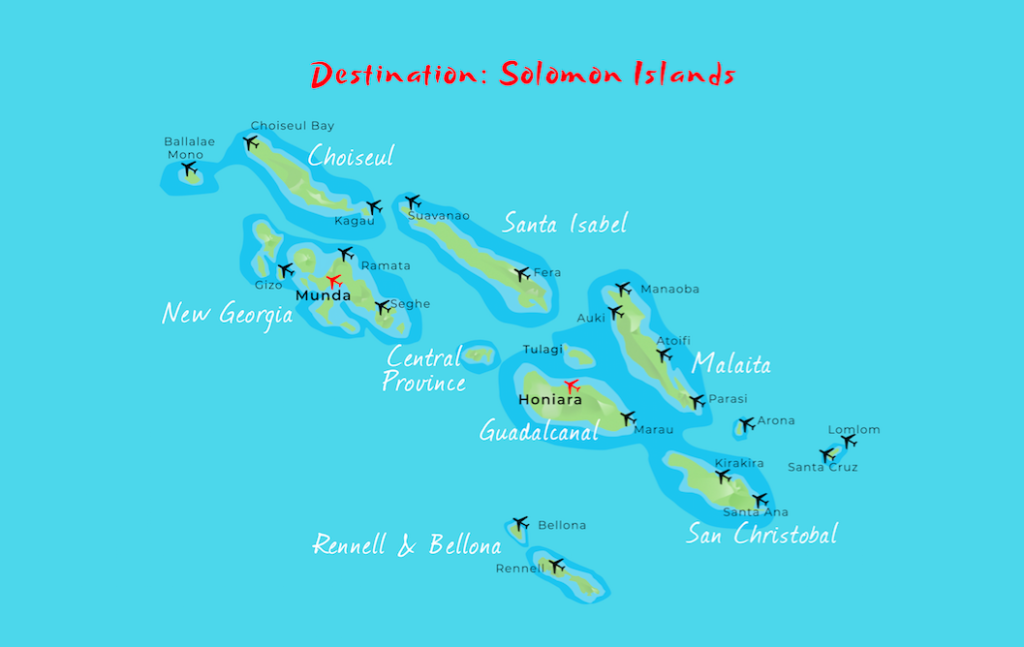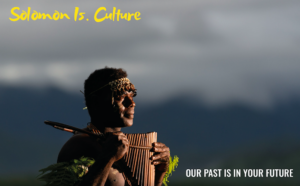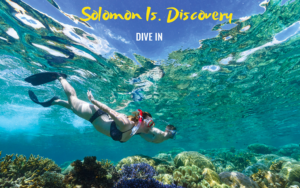About Solomon Islands
Location
Centred at longitude 160 degrees east and latitude 9 degrees south of the equator, Solomon Islands comprises 992 islands of which 147 are inhabited.
These stretch 1448 kilometres (900 miles) in a southeasterly direction from the Shortland Islands on the border with Papua New Guinea on the northeast to the Santa Cruz Islands, which borders with Vanuatu on the southeast.
The archipelago covers an area of 461,000 sq km (249,000 sq nautical miles) of which 28,446 sq km (10,938 sq miles) is landmass. The six biggest islands are Choiseul, New Georgia, Santa Isabel, Guadalcanal, Malaita and Makira.
On the atlas, Solomon Islands lie northeast of Australia and southwest of Hawaii. Deeply forested mountainous islands add a towering contrast to low-lying coral atolls, right down to the tiny artificial islands built of coral and soil common on Malaita’s northern coast.

History
Archaeological and linguistic evidence show that Solomon Islands was settled between 4000-5000 years ago by people from Southeast Asia.
From here, a group continued east and south settling in what is now known as Vanuatu, New Caledonia, Fiji and the Polynesian islands of Tonga and Samoa. It was not one way though as archaeologists point to a return migration of mainly Polynesians sometime later. Their descendants now live in atolls that border Solomon Islands’ northern, southern and eastern boundaries.
It was not until the 16th century that the Europeans came to learn of the Solomon Islands. Spanish explorer Álvaro de Mendana made the first contact in 1568. When he discovered alluvial gold on Guadalcanal, he thought he had found the source of King Solomon’s (of the Bible fame) great wealth and named it the Isles of Solomon. It was through his influence that many of the islands in the archipelago bear original Spanish names.
After Mendana, others mainly Dutch and French explorers made forays into the group. Then it was the turn of the Germans and British. The islands of New Georgia, Guadalcanal, Makira and Malaita became a British protectorate in 1893 with Tulagi proclaimed the protectorate capital in 1896.
The islands of Santa Cruz, Rennell and Bellona were included between 1898 and 1899. The Shortlands, Choiseul, Santa Isabel and Ontong Java were not part of the protectorate until 1900.
Japanese aggression turned the islands into a war theatre during World War II. Both the Japanese and allied forces suffered huge losses in land, sea and aerial battles.
Over 60 years later, the archipelago is littered with war wrecks and some of the country’s infrastructures today like airstrips and roads owe their existence to the war.
Solomon Islands gained independence from Britain on July 7, 1978. Twenty years later, in 1998, tribal rivalries erupted into armed hostilities on Guadalcanal which prompted Australia and its Pacific Islands neighbours to launch RAMSI, the regional assistance mission to Solomon Islands, in July 2003. Hostilities have ended and the nation is back on track with an elected government in power.



People
As Part of The Melanesian group of islands, which also includes Papua New Guinea, Vanuatu, New Caledonia and Fiji, the Solomon Islands was first settled by hunters and gatherers from Southeast Asia. Seafarers followed later.
Through the tracing of a distinct type of pottery called lapita, archaeologists say the original settlers of Polynesia in eastern Pacific trace their origins back to Melanesia, to Solomon Islands actually.
Today, between 70 to 80 percent of the population live a subsistence form of life in their small villages, settlements and islands away from the main urban centres. This number is expected to erode as people move from rural to urban areas for higher education and employment.
Religion
About 95% of The Population are Christians. The principal religions are church of Melanesia (Anglican) about 25%; Roman Catholic 19%; South Seas Evangelical 17% United Church (Methodist) 11% and Seventh Day Adventist 10%.
Other religions have made an impact notably the Baha’I faith, Jehovah’s Witness, Assemblies of God and Baptist.
Culture
Communal, clan and family ties remain strong in these islands with the existence of the Wantok system.
A key part of the Melanesian culture, Wantok means people from the same language group who are blood relatives. They are part of the extended family support and assist one another.
Kastom, the pidgin term for custom, refers to traditional beliefs and land ownership. Despite the predominance of devout Christians, traditional practices are still being followed especially by those living in the hinterland of the country’s larger islands.
Off the beaten path, village life remains much as it has been for centuries. While some do welcome strangers, not all do – so ask local authorities first before venturing to visit these remote and far-flung areas.
Flora and Fauna
The main Islands of Solomons are volcanic in origin covered with fast flowing rivers and streams. They are home to many endemic flora and fauna species, which includes the common cardinal lorry.
Current estimates put a total of 4500 plant species and 173 species of birds including the famous megapode bird that nests in the thermal sand of some islands in Central and Western provinces. In the World heritage listed Rennell Island alone, 10 plants and 4 species and nine subspecies of birds have been identified as endemic.
Also endemic is the saltwater sea snake known as the krait. A book written by Solomon Islander environmentalist Patrick Pikacha, titled “Wild West”, widely covers wildlife species ranging from birds to butterflies.
Economy
Driven By high commodity prices, the Solomon Islands economy had been performing quite well in recent years. In 2007, for instance, the economy grew by 10.3%, the highest in the South Pacific Region for that year.
It slowed down to around 6% in 2008 but an impressive growth rate nevertheless. Much of that growth was attributed to high levels of log exports. However, experts say current rates of tree felling are unsustainable, restrictions on log harvesting therefore have been imposed.
Good commodity prices for copra, cocoa and fish exports had also been helpful, and also stimulating the economy was the government’s expansionary fiscal policy, bulk of which is going towards building and improving infrastructure like roads and bridges.
Because of this and recent wage increases awarded to government workers, consumer spending has been bullish. That, together with high prices of imported goods, especially fuel, pushed inflation up to peak at 16.5% in 2008.
Commercial bank credit has also been strong, growing by 34.3%. Like other free market economies, Solomon Islands economy is not immune to the impact of the global financial meltdown. Lesser growth is being projected for 2009 and 2010.
Things might change for the better if the country’s sole gold mine Gold ridge overcomes funding issues and commences gold exports soon.
The security and safety that RAMSI brought to the Solomon Islands in 2003 has also provided a strong base for economic growth. New investors in the country are now able to start businesses with a renewed sense of confidence and certainty about the future.
*This information was provided courtesy of Tourism Solomons


